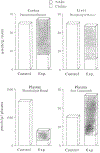Cholinergic mechanisms in startle and prepulse inhibition: effects of the false cholinergic precursor N-aminodeanol
- PMID: 8097917
- PMCID: PMC9170527
- DOI: 10.1037//0735-7044.107.2.306
Cholinergic mechanisms in startle and prepulse inhibition: effects of the false cholinergic precursor N-aminodeanol
Abstract
We examined the effects of cholinergic deficiency on prepulse inhibition (PPI) of the acoustic startle. Rats treated with a choline-free diet that contained the false cholinergic precursor N-aminodeanol showed great deficit in PPI. This deficit does not appear to be secondary to an increase of stereotyped behaviors. Startle threshold was also greatly reduced, as these rats startled to the 70-dB prepulse and the baseline startle amplitude was increased by 60% over the control rats. Arecoline (4 mg/kg) partially reversed the deficit in PPI. This improvement persisted beyond the period of drug treatment. On the other hand, scopolamine (1 mg/kg) reduced PPI in the control rats. These results suggest that cholinergic systems play a major role in both the elicitation and prepulse inhibition of startle.
Figures







Similar articles
-
Cholinergic modulation of the acoustic startle response in the caudal pontine reticular nucleus of the rat.Eur J Pharmacol. 1999 Apr 9;370(2):101-7. doi: 10.1016/s0014-2999(99)00156-9. Eur J Pharmacol. 1999. PMID: 10323257
-
Failure of haloperidol to block the effects of phencyclidine and dizocilpine on prepulse inhibition of startle.Biol Psychiatry. 1991 Sep 15;30(6):557-66. doi: 10.1016/0006-3223(91)90025-h. Biol Psychiatry. 1991. PMID: 1834231
-
Muscarinic cholinergic modulation of prepulse inhibition of the acoustic startle reflex.J Pharmacol Exp Ther. 2000 Sep;294(3):1017-23. J Pharmacol Exp Ther. 2000. PMID: 10945854
-
Selective immunolesioning of cholinergic neurons in nucleus basalis magnocellularis impairs prepulse inhibition of acoustic startle.Neuroscience. 2001;108(2):299-305. doi: 10.1016/s0306-4522(01)00413-4. Neuroscience. 2001. PMID: 11734362
-
Effects of scopolamine in comparison with apomorphine and phencyclidine on prepulse inhibition in rats.Eur J Pharmacol. 2000 Mar 10;391(1-2):105-12. doi: 10.1016/s0014-2999(00)00055-8. Eur J Pharmacol. 2000. PMID: 10720641
Cited by
-
In silico Gene Set and Pathway Enrichment Analyses Highlight Involvement of Ion Transport in Cholinergic Pathways in Autism: Rationale for Nutritional Intervention.Front Neurosci. 2021 Apr 20;15:648410. doi: 10.3389/fnins.2021.648410. eCollection 2021. Front Neurosci. 2021. PMID: 33958984 Free PMC article.
-
Cholinergic neurons in the pedunculopontine tegmental nucleus are involved in the mediation of prepulse inhibition of the acoustic startle response in the rat.Exp Brain Res. 1993;97(1):71-82. doi: 10.1007/BF00228818. Exp Brain Res. 1993. PMID: 8131833
-
Involvement of decreased muscarinic receptor function in prepulse inhibition deficits in mice reared in social isolation.Br J Pharmacol. 2011 Feb;162(3):763-72. doi: 10.1111/j.1476-5381.2010.01080.x. Br J Pharmacol. 2011. PMID: 20958289 Free PMC article.
-
Inhibition, executive function, and freezing of gait.J Parkinsons Dis. 2014;4(1):111-22. doi: 10.3233/JPD-130221. J Parkinsons Dis. 2014. PMID: 24496099 Free PMC article.
-
Reversal of scopolamine-induced disruption of prepulse inhibition by clozapine in mice.Pharmacol Biochem Behav. 2012 Mar;101(1):107-14. doi: 10.1016/j.pbb.2011.12.010. Epub 2011 Dec 21. Pharmacol Biochem Behav. 2012. PMID: 22210488 Free PMC article.
References
-
- Caine SB, Geyer MA, & Swerdlow NR (1991). Carbachol infusion into the dentate gyrus disrupts sensorimotor gating of startle in the rat. Psychopharmacology, 105, 347–354. - PubMed
-
- Carlton PL (1964). Brain acetylcholine and habituation. In Bradley PB & Finks M. (Eds.), Progress in brain research (Vol. 18, pp 48–60). New York: Elsevier. - PubMed
-
- Carlton PL (1969). Brain—Acetylcholine and inhibition. In Tapp JR (Ed.), Reinforcement and behavior (pp. 286–327). San Diego: Academic Press.
-
- Crofton KM, Dean KF, Sheets LP, & Peele D. (1990). Evidence for an involvement of associative conditioning in reflex modification of the acoustic startle response with gaps in background noise. Psychobiology, 8, 467–474.
-
- Crofton KM„ Sheets LP, Dean KF„ & Peele DB (1988). The effects of experience on gap inhibition of the acoustic startle response (ASR). Society for Neuroscience Abstracts, 4, 60.
Publication types
MeSH terms
Substances
Grants and funding
LinkOut - more resources
Full Text Sources
Miscellaneous

